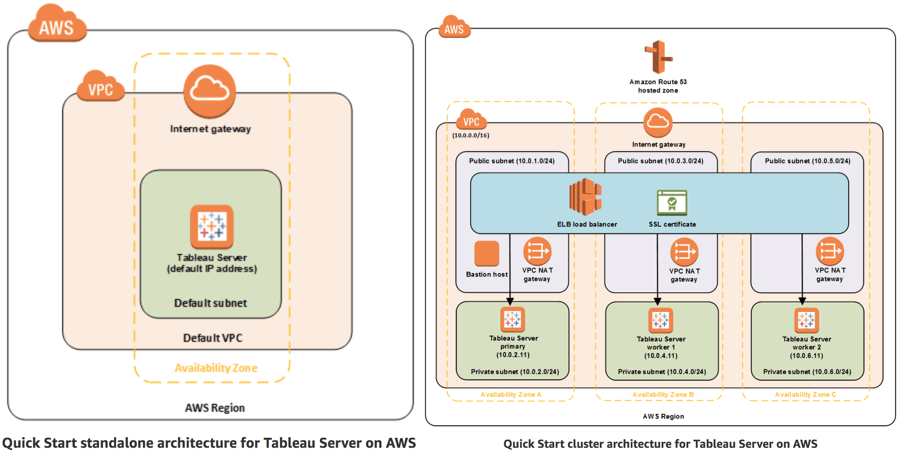Use Quick Start to deploy Tableau Server on the AWS Cloud, now with support for Linux
We’re excited to announce updates to Quick Start for Tableau Server on the AWS cloud, adding support for Linux. This updated Quick Start automatically deploys Tableau Server in a standalone or cluster environment on the AWS Cloud. And now, you can deploy on Linux in addition to Microsoft Windows Server.
In 2017, we launched AWS Quick Start, a solution with AWS to make it easier to deploy Tableau Server on the AWS Cloud—built based on AWS best practices for security and availability. Customers can launch, configure, and run the services required to deploy Tableau Server on AWS—all at the click of a launch button.
What’s new?
In this update, customers now have the ability to deploy on VPC’s running two different flavors of Linux.
How does it work?
This Quick Start uses AWS CloudFormation templates to install one of the following architectures:
- Standalone architecture: Installs Tableau Server into your default virtual private cloud (VPC) on an Amazon EC2 m4.4xlarge instance running Microsoft Windows Server, CentOS, or Ubuntu Server.
- Cluster architecture: Installs Tableau Server into a new or existing VPC on at least three Amazon EC2 m4.4xlarge instances running Microsoft Windows Server, CentOS, or Ubuntu Server. This option builds an AWS environment with VPC, subnets, NAT gateways, security groups, bastion host, and other components.

Why did we add Linux support?
We’ve heard how deploying Tableau Server on Linux helps customers both lower the overall cost of ownership and open up Tableau to a developer population that seeks greater control and security. We’re also increasingly seeing companies move away from on-premises deployments into AWS. And since most of the operating systems on AWS are a version of Linux, we wanted to create a frictionless path for customers to deploy Tableau Server on AWS—and do it with support for Linux.
First reactions: A conversation with AWS Certified Architect, Jonathan McDonald
To gauge initial feedback about the momentum following the Quick Start update, we spoke to Jonathan MacDonald, a seasoned Tableau Consultant and AWS Certified Solutions Architect with the The Information Lab, a Tableau Gold partner. Jonathan helps enterprises deploy and scale Tableau Server in the cloud.
Can you tell us what kind of feedback you’ve been receiving from clients regarding the Tableau Server on Linux launch?
We are seeing a HUGE amount of interest in the Linux release from our clients, who have either already moved over or are in the process of transitioning over from the Windows version. While some of our clients are (and always will be) Windows ‘shops,’ a lot of our other clients prefer to take a hybrid approach, using Windows/Mac for their PC/laptops and Linux for server infrastructure. And for almost all our new Tableau clients, we’re seeing a Linux-first approach to Tableau Server.
How does this fit in to the overall trend of companies shifting to the cloud?
In addition to the Linux uptake, there is also a growing movement to put infrastructure in the cloud. Just last week, I had five conversations with separate clients about deploying Tableau Server on AWS. These range from the smaller single-server installs, right through to the larger cluster installs for big enterprise deployments.
In your opinion, what are some of the biggest benefits of this updated Quick Start?
The beauty of the AWS Cloudformation templates and Quick Starts is that you can automate the deployment of Tableau Server on any scale in a fast, repeatable way.
I spent the last week helping a customer that provides data and analytics to the financial services sector build out a Cloudformation script. This script would not only deploy their Tableau Server, but also configure it to add their users automatically, talk to their SAML IdP, install and configure TabPy (python server for Tableau) and set up housekeeping scripts to automatically backup and maintain the server.
They are also looking at ways to automatically scale processes and worker nodes during peak load times. The ready-made AWS tools that Tableau has provided make this fast and accessible to mainstream IT sysadmins, where previously this was restricted to highly skilled DevOps specialists who would take days to write scripts from scratch.
Thinking about deploying Tableau Server on the AWS Cloud?
Get started with these resources:
- Learn more details about the AWS Quick Start architecture
- Read the deployment guide for Tableau Server on the AWS Cloud
- Looking for step-by-step self-deploy instructions? Read the online documentation for installing and configuring Tableau Server in the AWS Cloud (Linux).
Verwante verhalen
Subscribe to our blog
Ontvang de nieuwste updates van Tableau in je inbox.









